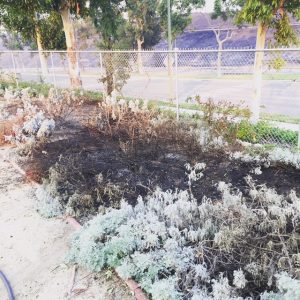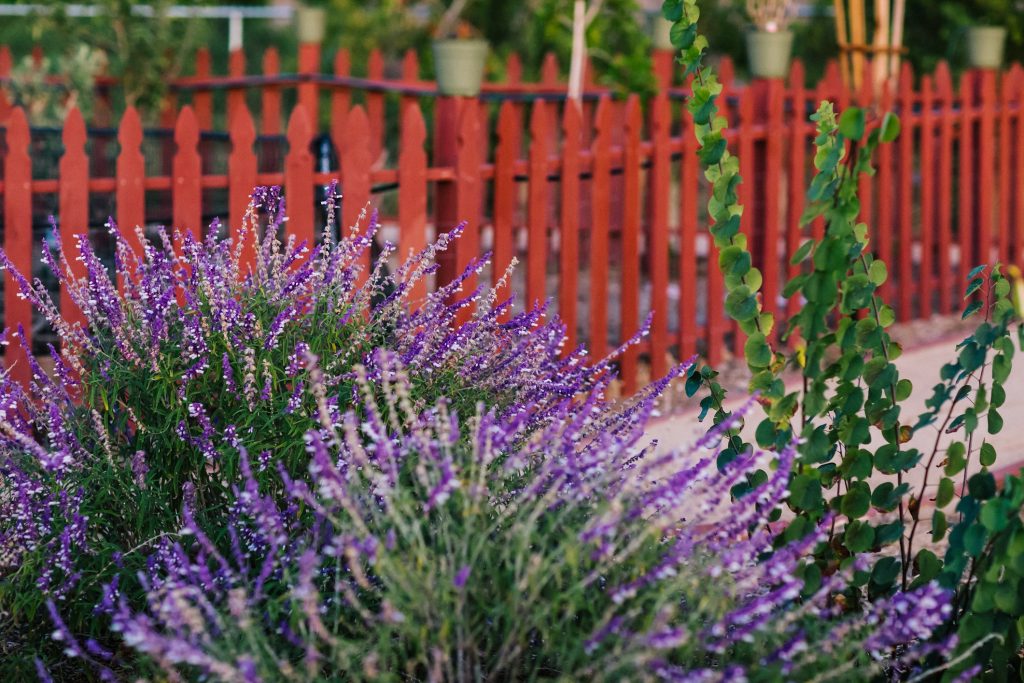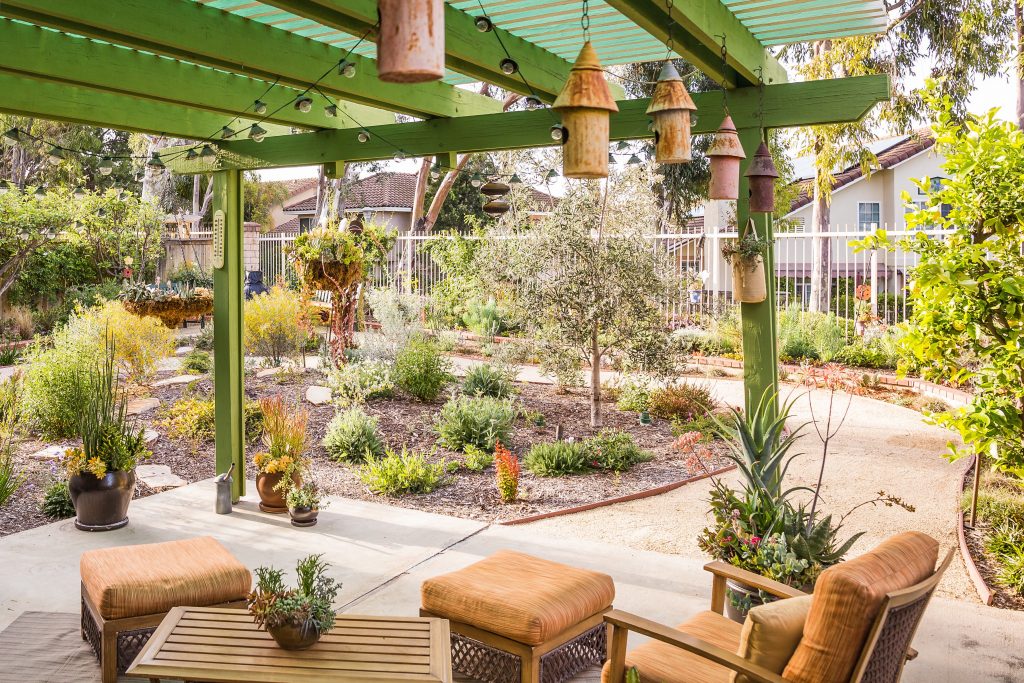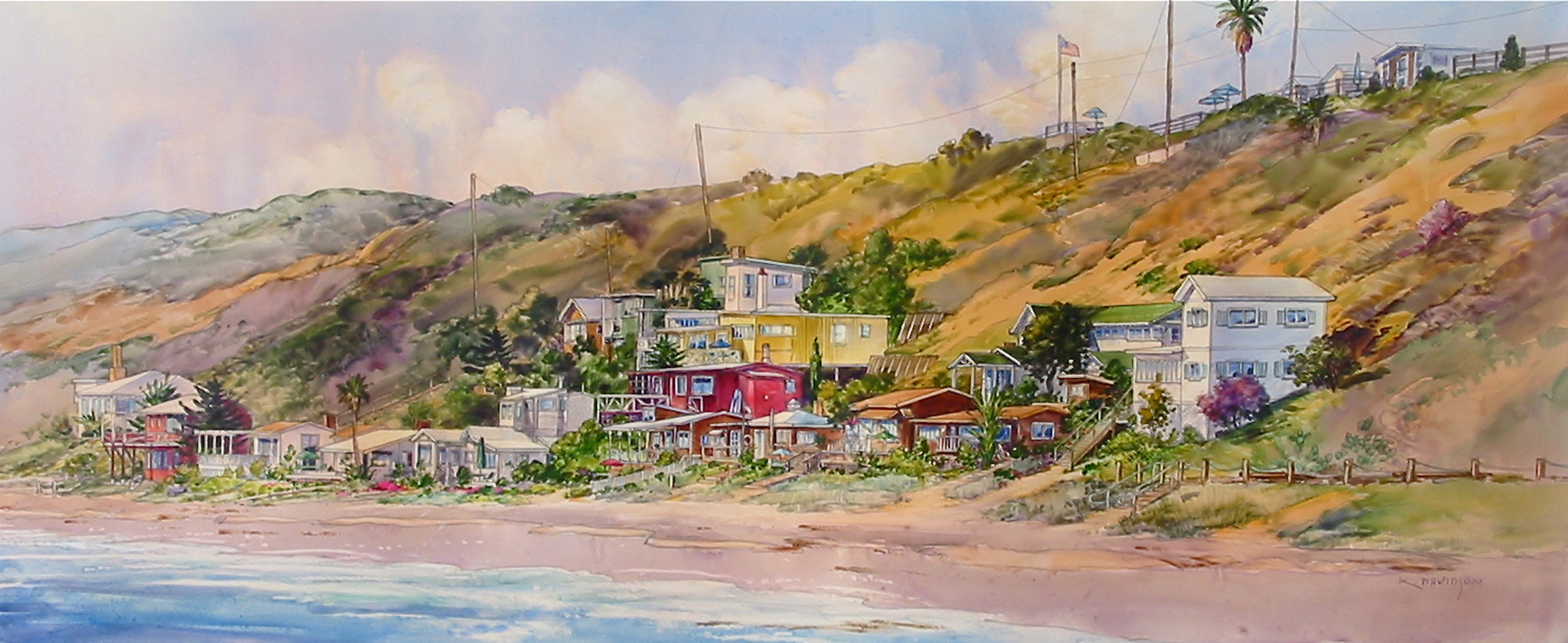Recent wildfires at Santiago Canyon skirted the Coastkeeper Garden. And unlike many homes in the area, the gardens were spared the fire-scarred landscape that now makes up the surrounding hillside. Garden director, Marianne Hugo of Orange County Coastkeeper gives good advice on how to plant with fire safety in mind for both garden and hillside landscapes.

Santiago Canyon fire.
Q: Wildfires have been destroying thousands of acres of lands in California in the last month. What are the after-effects on the landscape?
A: This really depends on what was burned and of course your perspective. If you are a homeowner, the results can be devastating. With the issue of a house burning, there are materials and toxic things that melt, especially if the garage has burned. Paint, weed killer, and household cleaners end up oozing into the soil making it toxic. When relandscaping after this circumstance, you need to be sure to take away the top 3 feet of soil to clear out the hazards. In Southern California this usually done anyway when creating a new landscape since the soil here is mostly clay and not a desirable planting medium.
Q: Another perspective?
A: If you are a naturalist or ranger a wildfire is a part of the environment’s cycle. For our recent fires, Peters Canyon, Santiago Canyon and the natural area behind Irvine Park hadn’t burned in over 20 years. They were full of dead growth and invasive non-native plants. A wildfire is nature’s way of cleaning house. It burns away and gets rid of all the plants we don’t want, giving a clean slate to replant with native foliage. If it rains this year, everything will turn green. It is a shame that the trees that burned were oaks, some over 100 years old. Luckily most will grow back from the roots underneath or from parts that weren’t burned.
Q: Can a home’s type of landscape make it less vulnerable to wildfires?
A: Yes, you certainly have options to improve your chances your plants won’t go up in flames. Ultimately nothing is fireproof. If fire is hot enough, everything burns. But to help protect both the landscape and your home, there are 4 things you can do.
1) Make a defensible space of 100ft around your home. This might be difficult in many parts of Orange County because builders have built us so close together.

2) You can choose plants that burn at a slower rate. The University of California, San Diego has done studies and calculated the burning rate of various plants. Overall the plants that burned the lowest are the drought tolerant ones. The majority of drought tolerant, low-water usage plants burn at a slower rate than traditional water thirsty landscapes. Low growing, open branching and limited leaf litter along with low quantities of flammable oils or resins contribute to their fire-resistance.
3) For each plant you want to have them at least two feet from each other. This is a mistake many people make. Plants that grow so close together spread the fire faster. If one plant catches fire, the other instantly does in a domino effect. When spaced properly, it takes flames longer to jump from plant to plant.
4) The final step is maintenance. Every 3 months trim and get rid of dead twigs and branches. Many people fail to get in there and pull out the dead debris. After 4-5 years without clearing it out, a big beautiful bush or tree is a timberbox waiting to ignite. Since most people don’t like to space out their plants preferring to bunch them up, it is very important to follow this last step.
Q: What about people with a home on top of a canyon or cliff?
A: If you have a slope you really do need to have the plants separated at a proper distance. Once a fire gets started, it is very hard to control due to the difficult access for firemen working to stop the wildfire. Again, when the plants are spaced apart properly the plants don’t catch fire so fast. Waterwise plants are best. Since they use less water, these plants are forced to have deep roots. The roots help provide stability to the hillside. If you are replanting the best time is November and December. The weather is traditionally cooler and the plants have time to establish their roots before it gets real hot. Even if you weren’t affected by the fire, right now is a good time to consider putting in drought tolerant plants.
Q: What types of plant are good in those areas?
A: There are drought tolerant shrubs you can plant on a hillside that give beautiful colorful blooms such as Tecoma stans also known as yellow trumpetbush. The Mexican Bush Sage has beautiful spikes of purple and white. A very popular large shrub is the red bird-of-paradise with its vibrant orange-red colors. These plants bring in native wildlife such as birds and butterflies. Choosing fireless-prone plants provides a beautiful hillside and at the same time uses less water, helps the environment and the roots keep the soil from eroding away.

Q: Is it best to use all native plants?
A: Native plants are drought tolerant. But not all drought tolerant plants are natives. Most non-native waterwise plants are from the Mediterranean region. The best thing to do is incorporate both of them together. Native plants have a dormant period where they die back, usually during the winter months from November to February. They have no color and not attractive during that time. The waterwise plants have a different dormant cycle. Planting waterwise plants with natives guarantees you will always have green and color and won’t even notice the dormant ones.
Q: How can you speed the recovery of a hillside devastated by fire?
A: If you have a serious slope that was burned, get a specialist to take a look at it. Even if you are a do-it-your-self type, it’s best to consult with an expert. You need to know the soil type, grade and elevation levels to properly relandscape. If there are existing plants, even if they are burned, do not pull them out. The roots are still in the ground acting as a hillside anchor. If your house burned in the fire, your insurance company should help you locate a specialist depending on what they cover. In Orange County the slopes are usually maintained by the HOA. You want to be very careful with replanting the slope. If it is not done correctly, heavy rainfalls can have disastrous effects with the hillside washing away. This could turn into a liability issue if there are homes or other structures below you.
CONTACT INFO
Marianne Hugo
Garden Director
Orange County Coastkeeper
8520 East Santiago Canyon Road
Orange, CA 92869
714.850.1965
marianne@coastkeeper.org
www.coastkeeper.org
By Gina Dostler



